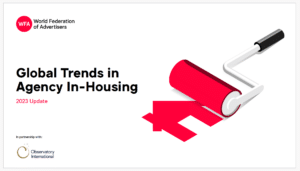In-housing set for rapid and continued growth at major multinationals
66% of brands now have in-house agencies, with 21% actively considering one.
70% already have strategic capabilities in-house and many plan to shift new tasks from external agencies over the next three years

Key findings from the latest report published by the Observatory international in partnership with the World Federation of Advertisers.
Two-thirds of major multinationals now have an in-house agency and a further 21% are considering establishing one, according to new research from the World Federation of Advertisers and The Observatory International.
The 66% figure represents a 16% rise on the number with these resources in 2020, the last time that this research was carried out. The number considering the in-house option is also up from 17% in 2020.
While most of these units are relatively fresh – nearly three quarters are between 1-5 years old – their skills are expanding and 70% of respondents now claim to have some form of strategic capabilities in-house – be it brand, creative or media, up from 65% in 2020.
The research suggests that many are also planning to expand the range and scale of their in-house operations. Over the next three years, 56% of respondents expect to move more digital production from external agencies to in-house, 33% of respondents expect to more offline production, 22% expect to transfer more data strategy work and 11% plan to move more data management and insight and analytics tasks over.
Online planning and buying are additional areas of future growth, with 83% of respondents expecting to handle some social media buying in-house over the next three years (up from 37% right now), 67% planning to add social media planning (up from 48%) and 50% want to take on digital media planning and buying tasks (up from 33% and 26% respectively).
The results are based on responses from 45 companies, with an estimated annual global ad spend of $60 billion. Seven percent of respondents are spending more than $50m annually on their in-house agencies, the same percentage spend $25-50m, 33% spend $5-$25m, 13% budget $1m-$5m and 27% spend less than $1m.
While cost efficiencies remains the strongest motivation behind the growth in the in-house function (83%) other factors such as quicker and more agile processes (76%), better integration (59%) and increased brand knowledge (59%) are also driving adoption.
Overall satisfaction with the work produced by these agencies is high at 86% and there was a significant rise in “complete satisfaction” – up from 23% on 2020 to 33% in 2023.
All respondents continue to work with external agencies, many of whom are still used to help deliver when in-house capacity is stretched.
“The rise of the in-house agency is one of the big changes in the way big brands manage their communications needs over recent years. While cost has been an initial driver of the trend, successful operations are demonstrating that they can deliver significant additional benefits such as speed of response. Greater maturity of the sector is also giving brands more confidence to expand their operations both in terms of scale and capabilities,” said Rob Dreblow, Global Head of Marketing Services at WFA.
One notable finding, however, is that the performance of in-house agencies is not measured on the same basis as those applied to external agencies. Measurement remains more focused on outputs than outcomes with the top three key measures of success (KPIs) were 1) 67% quality of work, 2) 47% speed to market, and 3) 40% cost savings.
Other key findings include:
- Change in challenges: in 2020 the big challenges were managing workflow (increased projects), project prioritisation and expanding capabilities and skillsets, in 2023 it’s integration between internal and external resources and overall resource management.
- Getting the best team: Talent attraction and retention are problems for 20% of respondents, though turnover remains low.
- Keep it central: A centralised studio model is most common – utilised by 67% of respondents (up from 50% in 2020) and workloads are increasing – 75% stating volume and complexity of work was up.
- Creative heavy: Staffing is dominated by ‘creatives’ (47%) with account management and production accounting for 18% and 20% respectively. Other functions include Traffic, Media and Operations.
- Agency structure varies (even within companies, which may use a range of operating models across their operations) a lot with 83% opting for full in-house resource but 28% using external embedded agencies and 24% utilising a pool of freelancers.
“Given budget pressures and a desire for faster, more efficient delivery of assets at lower cost, it’s unsurprising that the growth of those developing in-house offerings continues unabated. The rationale is obvious and benefits are considerable when you get it right. But if there is a ‘watch-out’ then it’s that, especially with content, businesses need to make sure they are not simply producing ‘stuff’ to fill expectation rather than need. Effectiveness is key to make sure that all your efforts aren’t simply wasted and potentially detrimental to both your business and, given the carbon footprint of digital activity, the planet,” said Stuart Pocock, Co-founder and Managing Partner of the Observatory International.’
To find out more please visit the WFA website.















